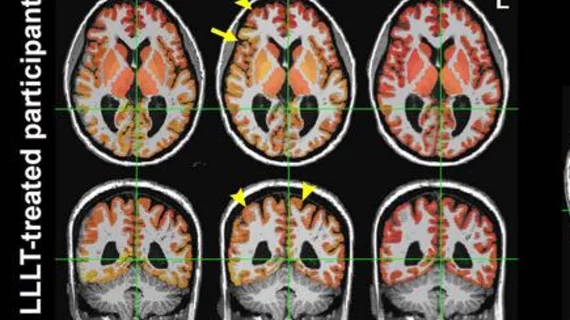Light therapy improves brain connectivity after head trauma, MRI study shows
Light therapy can improve connectivity after a mild traumatic brain injury, especially in the initial weeks following head trauma, according to new MRI data.
Researchers at Massachusetts General Hospital (MGH) arrived at this conclusion with the help of functional MRI technology. On imaging, the team observed improvements in connectivity in multiple regions of the brain in patients who underwent light therapy within the first few weeks of sustaining their injury.
“The skull is quite transparent to near-infrared light,” study co-lead author Rajiv Gupta, MD, PhD, from the department of radiology at MGH, said in a release. “Once you put the helmet on, your whole brain is bathing in this light.”
The group included 38 patients with a mild traumatic brain injury—some who underwent light therapy and some who did not—in their analysis. Patients received functional MRI brain scans while in a resting state to assess 82 different brain regions during three different phases of recovery: within one week, at the two- to three-week mark and then again after three months.
Imaging during the first two (acute and subacute) recovery phases showed improved connectivity between seven brain region pairs in the participants who underwent light therapy in comparison to those who did not. Between the subacute and late subacute phases, this figure grew to 13, but it was observed in both groups of participants.
Although light therapy proved beneficial during the first few weeks of recovery, the final scans did not reveal significant differences in connectivity between the groups.
“We were unable to detect differences in connectivity between the two treatment groups long term, so although the treatment appears to increase the brain connectivity initially, its long-term effects are still to be determined,” the group wrote.
The exact mechanisms that caused the light therapy to improve connectivity were not clear in the study either, the researchers acknowledged, adding that larger studies that utilize imaging beyond the three-month mark would be beneficial in understanding this. However, the experts are hopeful that light therapy will have a role in multiple aspects of improving brain health in the future.
“There are lots of disorders of connectivity, mostly in psychiatry, where this intervention may have a role,” Gupta said. “PTSD, depression, autism: These are all promising areas for light therapy.”
The study abstract is available in the journal Radiology.

